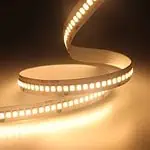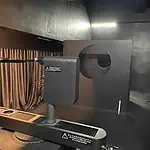Lumen and watts are two identical words that everyone capitalizes on when it comes to bulbs. Lumens are mainly used to determine the intensity of light emission from a bulb. However, the better the lumen depicts the brightness of the lights, whereas the infrequent lumen indicates its dimmer version.
However, watt predicts the units of power which the light has provided during emission. The greater the wattage of the bulb, the brighter the bulb’s illumination will be. An 80-watt bulb glows much more colorful than a 40-watt bulb.
Lumens Explained

Lumens can be termed as the distinction which is organized to commemorate the illumination of any lighting bulb. The higher the lumen generally indicates the spaced-out luminance of the bulb and vice versa. However, to point out the exact measured unit, it’s essential to figure out the reflection physics inside the lighting bulb.
Moreover, this particular measuring unit is more accurate than any other lighting unit used to establish the lumination of the bulb. Lumens also explains how the lighting spigot accomplishes its work without concerning electricity.
Lumens are denoted by “lm” and generally put forward the total visibility of the light from any light source to the human eye. However, lumens can be signified as the unit which judges the brightness of a lighting source.
However, at present, a new concept has arisen which depicts the advance of the energy-saving aspect of the light source. In this real advancement, the light’s intensity and brightness are determined with less electricity consumption.
How many lumens does someone exactly expect to attain in a bright environment? So such an exact number of lumens can be explained in this context. The concept of lumens is mostly dependent upon several factors like shape and size of the room, ceilings’ height, needs of the individuals, and specific type of light source.
Nonetheless, basic guidance concerning this topic is determined per Sq M (10.76 square feet). In this aspect, the dimension of the room works as a crucial feature. For different rooms of a residence, distinctive types of illumination are required. For the kitchen, 300 to 400 lumen/Sq M is required, whereas, for the bathroom, 500 to 600 lumen/Sq M can be considered.
Watts Explained

Everyone around the globe prefers buying every lighting bulb concerning its watt. But why? Watt represents the power unit which indicates the usage of energy of the lighting source during emission. People are pretty conscious about buying bulbs after looking at the watts.
The high range of wattage of a bulb depicts the brighter version of it or vice versa. After having a precise vision of the bulbs, you can point out the filament. It’s the ma where the electricity passes and provides brightness and warmth.
At present, advanced technology has helped to shape numerous things. Likewise, some changes have also taken place in the entire curriculum of the bulbs. The bulbs are now more efficient and don’t consume much energy and thus reduce the load on electricity bills. It’s because of the transition in fundamental working principles. However, the newly invented bulbs are much brighter than the prior ones.
Lumens Vs. Watts- Compare & Contrast
Compare
Functionality
Lumens depict the brightness of the light sources: the more lumens, the brighter the light source’s illumination, and vice versa. However, the value of the lumens differs from the type of light sources according to the lighting sources or technologies used to turn electric energy into heat energy, and watt is about the power consumed by the bulb. If the brightness of the light source increases, then it indicates the achievement of more energy-efficient lumens along with lower power consumption.
Standardization
Lumens put forward the total, or the exact value of, the light a lighting source has emitted. Estimating the brightness of a bulb is not an easy task. So the brightness can be determined by looking at the wattage ratings of the bulb. It’s because the wattage ratings indicate the brightness level of the light source.
Contrast
Relation Between Lumens And Watts
An incandescent light bulb of 100W produces an average value of 1600 lumens. Then the entire statement can be summarized by saying that the value of 1 Watt will be 16 lumens. This value can be obtained by dividing 1600 lumens by 100W.
Translation Of Lumens Into Watts
For the conversion of lumens to watts, it’s essential to find out the luminous efficacy. This particular juncture of the lighting source is determined in lm/W. So to get the value of luminous efficacy, it’s crucial to figure out the power and wattage of the bulb. Hence, power can be obtained by dividing flux by luminous efficacy.
Comparison Table Of Different Bulb Types
The table will illustrate the distinctive features of each type of bulb, like Incandescent, Halogen, CFL, and LED bulbs. After looking at the table, the audience can quickly note down the points which make each type different from the other.
| Features | Incandescent | Halogen | CFL | LED |
| Consumption | 100w | 70w | 20w | 12w |
| Efficiency | Low | Low | Medium | High |
| Average Lifespan | 1 year | 1-2 years | 10 years | 25 + years |
| Price | Low | Low | Medium | High |
| Operating Cost | High | Medium | Low | Low |
Lumens To Watts Conversion
- Explain what lumen-to-watt comparison
From the above brief explanation, it’s pretty evident that lumens and watts are two parallel bulb sections. Lumen implies the measurement of the total quality of the source of light. In contrast, watts explain the power consumption amount by the bulb.
On the other hand, watts don’t clarify the brightness of the light source, but lumen can easily explain every juncture of this topic. For example, a 60W incandescent light bulb can radiate around 650-850 lumens. In this case, if 750 lumens is the average radiation, it can be quickly concluded that 1 Watt = 12.5 lumens.
- Give the formula for conversion
In physics, the lumen is explained as lm, whereas the watt is expressed as W. Lumen is nothing but the standard unit concerning the luminous flux. In other terms, it can be stated as the emission or flow of light which comes out from the light source in any respective area per unit of time. In contrast, a watt is the typical unit of electrical power for the time. It’s measured in joules per second.
For conversion, the expression or the formula will be flux / luminous efficacy = power and lm/ (lm/W) = W. The unit of this converted expression will be lm / W.
- Explain the conversion formula to readers
Suppose someone wanted to figure out the approximate or the exact amount of power consumed by the light source. If the light source is an incandescent light bulb, it will have a luminous flux of 1,120 lm. The luminous efficacy of an incandescent bulb is 14 lm/W. Then the energy consumed by the bulb will be = (1,120 lm) / (14 lm/W) = 80 W.
Luminous Efficacy Explained

Determination of the luminous efficacy is when the lumens are determined in terms of watts. However, in other words, it can be explained as the capability of the bulbs to convert watts to lumens. The older technology had a very low luminous efficacy.
15 lumens per watt can is the efficiency of incandescent bulbs, and the capability of LED lights can provide almost 140 lumens per watt. After observing both the units of power of different types of bulbs, the energy-saving concept of the light source is quite evident.
Watts doesn’t play any role in determining the brightness of the lighting sources but has provided a different aspect concerning the luminous capability.
However, this efficacy is not the same for all manufacturers; it deviates. It’s essential to check the working capacity of the company to figure out the bulb’s efficiency. In the luminous efficacy list, LEDs have always acquired the top-notch with a luminous efficacy of 80-100 Lm/W.
Lumens Recommendation For Different Rooms
Kitchen
The kitchen is one of such corners of the house in which bright light falls under necessity. That’s why generally, people recommend installing the range of a 1000-lumen LED to a 1600-lumen LED bulb to have an ample amount of brightness in place. However, the brightness of the light source will also assist in staying alert during cooler temperatures.
Dining Room
People tend to brighten up their dining space. For the bright ambiance, it’s vital to get your hand around the range of 440 to 800-lumen bulbs. Apart from all, these dim light sources are considered the best for dining rooms as they work best in warmer temperatures.
Living Room
The living room is the definite place where someone can relax adequately, and sometimes people also choose to work there. It’s essential to take up the bulb range of 230 – 440 lumen.
Bedroom
The bedroom is a relaxing room where people generally prefer dim light with a soft ambiance to relax. That’s why a 230 or 270-lumen light is recommended. For this, it’s better to introduce a different, dimmer light tone.
Home Office
In the workspace, people need brighter light to put all their concentration on their work. However, in the workplace, computers or laptops are two main junctures. Looking constantly at their screen can cause harm to the eyes. That’s why a range of 800-1000 lumen bulbs should be used in the workspace.
Bathroom
Bathrooms are where some like to stay for a long time, whereas others want to come back quickly. So a range of 330 – 400 lumen light should be used in the bathroom. However, the light effects or times can be changed according to the temperature.
Workspace
You need enthusiasm and zeal to put all your concentration into work. For such energy, one needs a bright tone of light in his workspace. Nonetheless, for the workspace, an approximate range of 8,000 to 10,000 lumens is required.
- Ensure Reading The Light Bulb Label
Before buying a bulb, it’s better to scroll down your eyes on the energy labels. These labels educate the buyers about the lamp’s efficiency in terms of energy. Energy labels also illustrate the maximum energy the bulb can consume or how much pressure it can exert on the electricity bill.
In a bulb, the filament acts as the catalyst, which helps in the outpour of energy and heats it. This entire procedure instigates the bulb to glow brightly. However, this procedure demonstrates the conversion of electrical power into heat energy. On the other hand, the energy labels depict how efficient the light source is.
The efficiency of the bulbs is agreed upon on a definite scale. The efficiency scale of the light source falls under the range of A++ to G. A++ indicates the most efficient juncture of the bulbs, whereas G depicts the least efficiency.
The energy label depicts the unit of power of the bulbs. In standard terms, it illustrates the watts of the bulb. Additionally, demonstrate the energy-saving theory of the bulb. Along with watts, the label also points out the brightness range or the specific brightening numerical of the bulb. Moreover, it symbolizes the lumens and hence familiarizes the buyer with the level of brightness the bulb can provide. The energy labels furthermore offer knowledge about the life span of the bulb as well.
- Color Rendering Index
The color rendering index (CRI) is another point regarding any light source. It informs about the appearance of the colors under the bulb. The index generally falls between 0 to 100. However, Halogen bulbs have the exact color rendering index of 100.
To be very specific, CRI is used to figure out the proportion of the natural color of the light source indicated under the circumstances of any artificial white light source. However, CRI is also described with sun rays. If the CRI of a light source is 80 or more than that, then it’s considered acceptable. Whereas the CRI of 90 is much more promising than the prior ones.
- Color Temperature
The color temperature conveys the appearance of the light emitted by a light source, especially a bulb. However, the temperature is estimated in Kelvin (K). The extent of the color temperature is measured within the range of 1,000 to 10,000.
To be very specific, in terms of residential or any commercial lighting source, the color temperature is under the scale range of 2000K to 6500K. The capacity or any specific numerical value of the color temperature concludes whether the source of light is considered as “cool white” or “bright white” light.
The energy labels of the bulbs also elaborate on the light colors, allowing individuals to see objects. High energy-qualified light sources or bulbs have an acceptable appearance range of 2700K to 3000K (K = Kelvin). However, the higher the stars, the higher the light appearance range.
- Light Emission Color
The frequency of light emission is determined by electromagnetic radiation. However, this emission is all because of the electrons, which are responsible for making the transition of light energy from a higher state to a lower one. However, the emission of the light energy is identical to the emitted photons within the two energy states.
The transition of each electron concerns specific energy ranges as well as differences. However, each distinctive growth helps to specify the wavelengths of the light source and thus makes prominent notifications about the emission spectrum. This emission spectrum of each element is different and doesn’t have any reference with each other.
Why LEDs?

- Lifespan
LEDs last more than traditional bulbs. It’s because of the advanced lighting technology integrated into LED lights. However, LED lights work almost 2-3 times more than any other bulb type.
- Effective Directional Emissions
The light emission technology of LEDs is made to provide light at 180 degrees and even 360 degrees of the surface around it. In other perspectives, along with providing a large spectrum of light, it also helps to control redirecting the light of the other corner of the room for glare.
- Design Variation
The entire structure of LED lights is generally tiny. So it provides a difference to these lights. LEDs can be used in a bunch, or sometimes they can also be used separately. The variation in the entire structure can be made according to the necessity of the users.
- Great Color Rendering Index (CRI)
LEDs have high CRI because these LEDs are used around the globe. As of this, the visibility of the objects is much more apparent in LED rather than in natural lights.
- Correlated Color Temperature (CCT)
LEDs are available in a wide range of correlated color temperatures (CCT) are available in LEDs. CCT indicates the tone of the LED lights and hence shows its variation. CCT can come up in warm, calm as well as yellowish glow. An even white tone range is also available.
- No UV Rays Emission
The emission of LEDs in a specific spectrum and, thus, the range of the infrared spectrum doesn’t spread widely. As a result, the stretch of the UV rays is almost negligible. However, this depicts that LEDs are safe and don’t contribute to the emission of UV rays.
- Environmentally Safe
In lighting sources, light bulbs illuminating solutions like mercury vapor or fluorescent are used to pitch in a lot of environmental pollution. However, none of the answers are incorporated in LEDs to emit light, and hence it can be termed as eco-friendly.
- Power Consumption
LEDs can consume less voltage or electricity, which asserts less pressure on electricity bills. It’s one of the main reasons people choose LEDs over any other type of bulb for outdoor or indoor lighting.
More information, you can read Advantages and Disadvantages of LED Lighting.

FAQs
There is no direct relationship between lumen and watt. Lumen indicates brightness, and watt speaks about energy output. Both of these elements are the crucial junctures of bulbs and assist in assembling the efficiency of the lighting source.
The standard incandescent bulb of 60W can produce a lumen between 650-850 if we pick it out. If we pick out the average number of lumens to be 750, it can be easily said that 1 Watts = 12.5 lumens. This numerical value of the lumens is obtained by dividing 750 lumens by 60 W.
However, 263 lumens are considered on average concerning the capacity of a 20W halogen MR16. Then the entire statement can be concluded by saying that the 1 Watt = 13.15 lumens. If a 6 W LED is considered with an average result of 260 lumens. Then the value of 1 Watts will be 43.3 lumens.
Before saying that 800 lumens are more, it’s essential to figure out which corner of the house you choose. For your dining space, 800 lumens can be considered best, as people appreciate having a bright ambiance near their dining space. The brightness provides the enthusiasm and interest to have food which the dimmer light fails to do. That’s why choosing a range of 400 – 800 lumen bulbs is utilized.
1000 lumen is used to see things that are situated far enough. However, 1000 lumen provides too much brightness, making things visible at a distance. The rays from the lumens help to focus the things presented with the maximum distance range of 150-200 meters. However, the visibility also depends upon the design and structure of the object situated at a certain distance.
Every room or corner of the house depicts its essence. It’s not at all possible to fix dimmer or brighter in every room. That’s why it’s essential to choose the correct tone of light for every room. In the dining room, mainly brighter light is chosen, whereas, in the bedroom, dimmer light is adequate.

Conclusion
At present, the arrival of new technology has put forward several new components in bulbs. These technologies indicate the energy-saving designation of the light source. Nonetheless, the new ones are gradually overpowering the older ones in terms of advancement and market acceptance.
From the above-illustrated sections of the content, hopefully, the audience quickly figures out the difference between watts and lumens. However, they must have acquired the vision of all points they should know before grabbing any bulb and understanding the features of each.
Additionally, it’s known to everyone that people around the globe have used LED lamps, and in every aspect, the audience prefers them. After reading out the brief description under the heading “why LEDs?” The audience must have notified the rationales for choosing it. In the other sections of the composition, the lumen guidance is mentioned according to every room of the house.
LEDYi manufactures high-quality LED strips and LED neon flex. All of our products go through high-tech laboratories to ensure the utmost quality. Besides, we offer customizable options on our LED strips and neon flex. So, for premium LED strip and LED neon flex, contact LEDYi ASAP!





